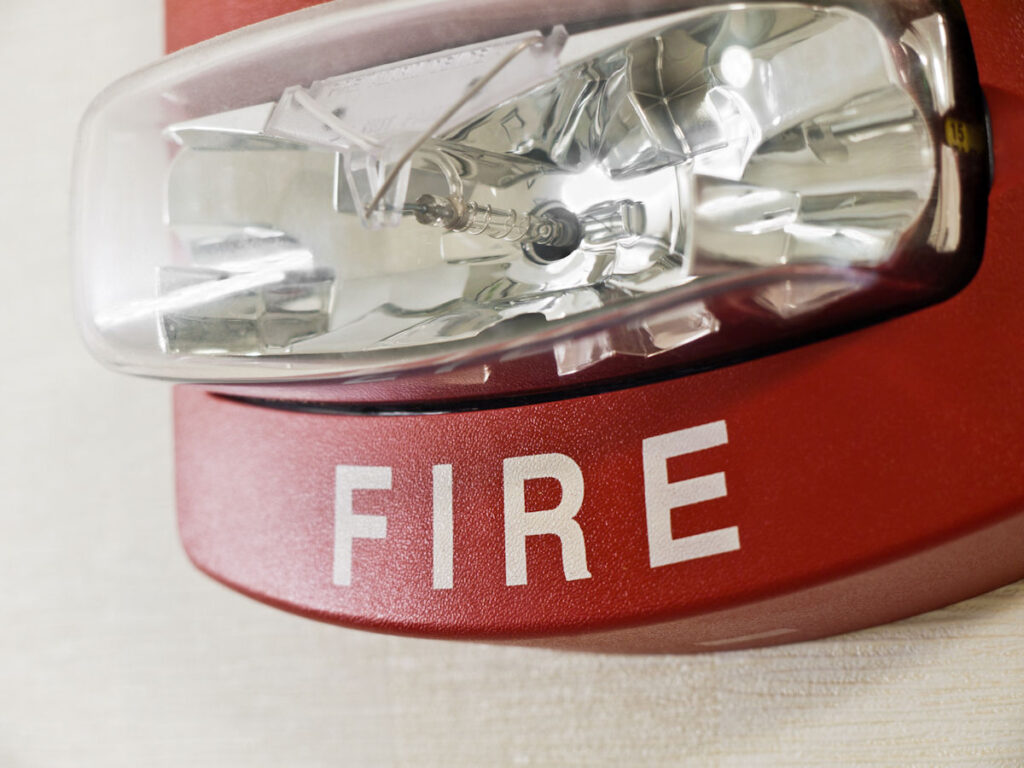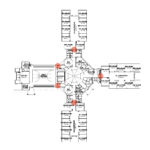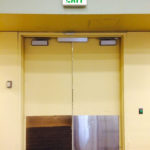 Last week I answered a quick question about locking stairwell doors, and Jim Elder of Secured Design raised a great point in a comment on the post. It is permissible by code to lock interior stair doors in schools and other types of buildings, but there are model code requirements for releasing the locks on the stairwell side. This allows building occupants to leave the stairwell if it becomes compromised during a fire (here’s a short video about stairwell reentry).
Last week I answered a quick question about locking stairwell doors, and Jim Elder of Secured Design raised a great point in a comment on the post. It is permissible by code to lock interior stair doors in schools and other types of buildings, but there are model code requirements for releasing the locks on the stairwell side. This allows building occupants to leave the stairwell if it becomes compromised during a fire (here’s a short video about stairwell reentry).
In several recent school shootings, the fire alarm has been activated during the incident. Currently, the International Building Code (IBC) and International Fire Code (IFC) require locked stairwell doors to be unlocked by a signal from the fire command center or other approved location. But beginning with the 2024 edition, the I-Codes will also require stair doors to unlock upon activation of the fire alarm and/or upon power failure.
If the adopted code requires stairwell doors to unlock upon fire alarm activation, and the alarm is activated during a lockdown, the stair doors would then allow access to other floors of the building. I am not a fire alarm expert, but I know that in some jurisdictions the AHJ will consider a plan for schools to secure-in-place for a limited period of time when there is an unplanned fire alarm. For example, the Indiana Department of Homeland Security has issued a bulletin called Guidance to Schools for Unplanned Fire Alarms. The bulletin states:
If a school is equipped with a positive sequence fire alarm system, the school may develop a plan to investigate an unplanned fire alarm activation before activating the audible and visible alarms requiring evacuation. Such a plan must include a designated school official with proper training to acknowledge an alarm has been activated and initiate an investigation within 15 seconds. These schools can secure-in-place for up to 3 minutes in order for the designated school official to investigate the unplanned fire alarm activation. Following the 3-minute period, the school must evacuate, unless an active shooter is verified to be on the school’s property.
The bulletin also clarifies that doors may not be barricaded or blocked, and that egress must not be obstructed. Read the complete bulletin here. As noted in the bulletin, activating the fire alarm during an active shooter incident could cause building occupants to begin evacuation, exposing them to the shooter. The response to an unplanned fire alarm – including the status of the stairwell door locks – is an important consideration when creating a school security and safety plan.
You need to login or register to bookmark/favorite this content.










Washington state used to require pull stations at school exit doors. As of about 8 or 10 years ago, a pull station is only required at a central location (commonly the reception desk). Fire sprinklers are required in new Washington schools, so if there was a fire which activated sprinklers, that would be known to the person at the central location.
Thanks Joel!
– Lori
So I am a slow thanker.
Safety vs Security always the challenge.
My rant, is not ever “””Emergency is a Fire””
Staff, school nurse, EMS, police, school resource officer, might just have to get through the locked stairwell door.
They might not know to activate the fire alarm??? Or have a key to open the door.
Just some thoughts.
Hi Charles –
During normal operation, these doors would likely be open and unlocked. If there is a fire alarm, the door would close automatically. If it’s a lockdown, the door would ideally close and lock (on the stair side), to keep the shooter from moving around the school. Emergency responders would need a way to unlock the stair door, just as they would need a way to unlock the exterior door and the classroom doors. They could use a key or electronic credential, and this would be part of the plan and the lockdown drills.
– Lori
Fire doors and shutters
A number of years ago while doing new construction (and remodeling in existing building) I inspected a bank that shared an underground parking ramp. The connection between the two structures was a 2 hour rated exit stair, which also served as an elevator lobby.
The entry into the stair was also required to have card access and handicap access from the garage to the bank, as well as exit egress sensors from the bank side.
There was a window between the underground ramp and the stair-elevator lobby. The window was fitted with a fire shutter. It was not placed on the side of the hazard (the underground parking garage which was the hazard, but on the side of the elevator lobby-stair.
To attain the correct code required functions of the individual pieces of hardware to work in unison, it required a meeting of all interested parties. After several conversations between contractors, architects, hardware suppliers, we had a meeting with owners, architects, hardware suppliers, owners, ADA info, hardware designers with UL listing info, and the business being shared with a private bank and State owned property. We found a code compliant solution.
The Fire Marshal doubting the prevalence of the problem, attended a code seminar in Chicago (I couldn’t go… too many inspections). When he asked code questions about the subject, he was informed that they had not encountered any similar issues
Much to his credit (of which was leanly given), he inspected the facility in which the seminar was being given, and found that the building, in which the seminar was being given, did not meet the code (especially the code being taught).
Now in that period of time I had 276 buildings with similar hardware from daycares to hospitals. There were 3 which passed on the first inspection. Some of which were undone with subsequent remodeling. Fire inspection code compliance is not the same as Building Code compliance, as I have seldom seen an unsafe building until people occupy it
Is there any question on why I appreciate “I Dig Hardware”
Fire Prevention Officer Retired.
I don’t know how AHJs do it all…you have to know so much about so many things, and my entire job is one little part of that! Thanks for the appreciation! 😀
– Lori